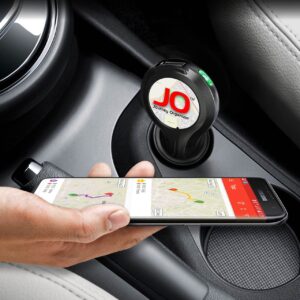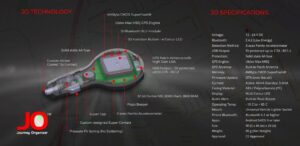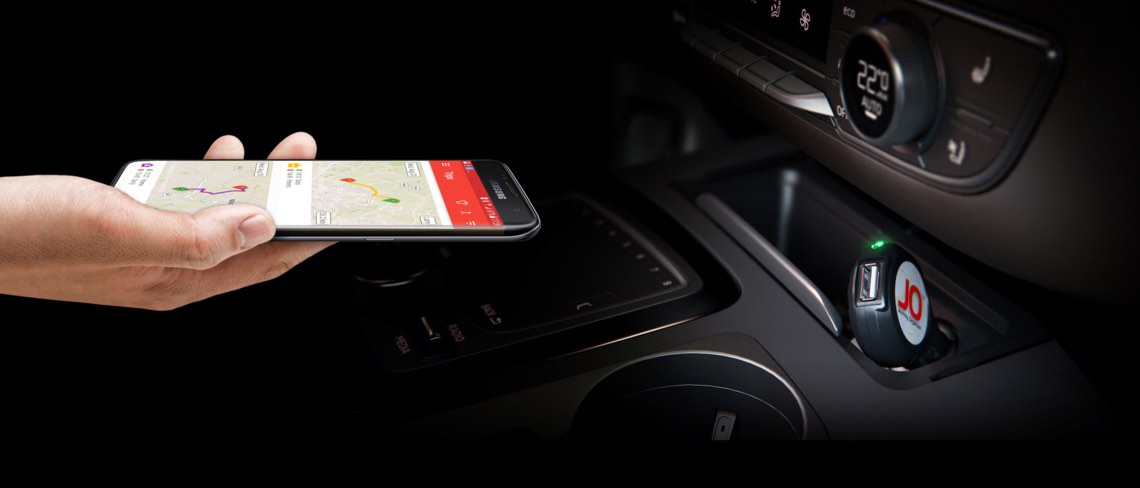The South African company Sanji is changing how businesses and professionals log their car trips with Journey Organizer, or JO, a GPS dongle that connects to a vehicle’s cigarette lighter. And because power management is such a crucial aspect of this design, the company decided to use our L7986TR 3 A step-down switching regulator and our LDS3985 very low drop-out and low noise 300 mA regulator. Furthermore, the JO integrates our LIS2DH12 ultra-low power three-axis accelerometer for motion detection, thus enabling features that would have been impossible to incorporate into such a small device. The high efficiency and low power consumption also allow for the presence of other components, such as a Flash memory capable of storing about two months’ worth of trip data.
One of the most common challenges among design teams is the fact that they often underestimate the difficulty of coming up with the right hardware platform. A device like the Journey Organizer is even more complicated because it has to rely on the power supply from the car lighter and must fit a GPS tracker and many other components in a tight package compatible with a vehicle’s console. What is even more difficult for companies to comprehend is that parts that are too often overlooked, like power regulators, can make or break a design. As a result, we offer tools like eDesignSuite to help engineers simulate their design to find the right component and optimize their system. We also ensure that our vast selection of power components can help designers offer more features, as is the case with JO.
Going the Extra USB Mile

One of the critical features of the Journey Organizer that doesn’t get enough attention because it is not always apparent is its 5 V / 2.7 A USB connector. Traditionally, passengers charge their phones by using a car adapter but since the JO is using the interface, it was essential for Sanji to provide a solid replacement. However, the company went the extra mile by offering a port that’s compatible with fast charging solutions. Even some smartphone manufacturers still ship their flagship products with a much more traditional 1 A charger, which means that Sanji went far beyond classical expectations to offer a fast charging connector that would help customers top up their batteries faster, which consequently improves the power cells’ lifespan.
The L7986 is the 3 A step-down switching regulator that makes USB fast charging possible. It is able to feed the USB controller with the right current, and it is perfect for the JO thanks to its wide input voltage range that goes from 4.5 V to 38 V. Indeed, not all car lighters are equal, and some may not offer the cleanest power source. Additionally, to distinguish itself from the competition, Journey Organizer needed to also work in trucks where lighter receptacles output 24 V instead of the 12 V available in cars. Thanks in part to our regulator, JO is able to adapt to both situations, which is quite unique in this industry.
Driving Toward Efficiency

Another vital component of the Journey Organizer’s design is our LDS3985 LDO. To properly feed the main microcontroller and a slew of offer parts, the PCB needed a low dropout, but it also required astonishingly high efficiency. Indeed, the JO must remain small to offer the best user experience. A humongous product sticking out of the car lighter is not only hideous but potentially impossible to connect adequately. However, if the package is small, but the power efficiency isn’t high enough, the company could end up with thermal dissipation issues, and it’s evident that the last thing drivers need when they are on the road is to worry about an overheating dongle. It was thus imperative to find an LDO that could meet these requirements.
The LDS3985 offers a tremendously low drop with a maximum current of 300 mA and a dropout voltage of 150 mV at that load. As a result, it provides a wide range of output voltages from 1.25 V to 5 V with 100 mV steps, which is sufficient to power the system’s components that require 3 V. Our LDO also tolerates a wide range of inputs from 2.5 V to 6 V, which means that any variation from the 5 V supply is not going to cause a problem. Additionally, its low output voltage noise of only 30 µVRMS will guarantee a clean output power to sensitive components by preventing damaging voltage ripples.
Knowing When to Stop
The JO must also deal with unique challenges, one, in particular, being that some vehicles never shut the power of their car lighter. As a result, a dongle with no means of bypassing this issue would continue to draw a non-trivial amount of energy from the battery even when nothing is happening, which is clearly suboptimal. Sanji thus included our LIS2DH12. With its power consumption as low as 2 µA, our accelerometer is perfect for such a small design, and it enables the company to shut down its system after the car remains immobile for a certain amount of time. Similarly, the accelerometer will wake the Journey Organizer when it detects movement. However, it was imperative to have components that could remain highly efficient, even when just supplying the sensor responsible for detecting movement and waking the system up.
This is the reason why Sanji chose our LDO. One of the most important features of our LDS3985 is its impressively low quiescent current of 85 µA at no load and 200 µA at 300 mA. Traditionally, components offering such a low drop tend to have a much higher current consumption when the load is minimal. However, thanks to its architecture, it is able to offer a much higher efficiency when the JO is in a power-saving mode. Furthermore, our LDO also uses ultra-low ceramic capacitors which ensure fast transient responses that translate in a fast turn-on time of typically 240 µs, meaning that the system will wake up fast enough to be operational very quickly.
The Journey Organizer’s Final Destination
The Journey Organizer primarily sells in South Africa, but thanks to a distributor in the United Kingdom the device is starting to conquer Europe. Its mobile app is able to log the data from the GPS tracker as well as send them to a cloud service, and the program can define geo-fences to exclude certain areas. It also means that the JO doesn’t need a GSM module since it uses a Bluetooth LE connection to communicate with a smartphone. Additionally, users do not necessarily have to take the JO out of the car to connect it to a PC. They can just turn on their mobile application once in a while and upload their data. All this is possible because of a highly efficient and reliable hardware platform that draws from powerful components to offer unique features. This is the great lesson that should always drive designs.
